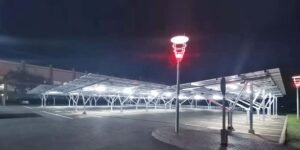What to consider when considering an off grid solar system
Living in Africa comes with a major benefit: we get a lot of sun! Using the sun to generate electricity through solar power is beneficial for the environment and your electricity bill. More and more businesses are investing in their own off grid solar system to enjoy these benefits and lessen their reliance on shaky national power grids.
In this blog post, we summarise the key components of an off grid solar system, which is also referred to as a microgrid system.
Off grid Solar Power System – What Components are typically used?
For most DC-coupled off-grid systems there are four main components – solar panels, charger controller, inverter and a battery bank. Naturally, there is a lot more than that, but those are the four main elements that will be discussed in this article.

Solar Panels and mounting
Starting with the most obvious part of an off-grid solar system are the photovoltaic (PV) solar panels. When the sun shines onto a solar panel, energy from the sunlight is absorbed by the PV cells in the panel. This energy creates electrical charges that move in response to an internal electrical field in the cell, causing electricity to flow. Solar cells are the small squares that make up the entirety of the panel itself. While you do get monocrystalline and polycrystalline solar panels , these days, monocrystalline panels are most commonly used in commercial and industrial systems.
Determining the size of the solar array is one of the most significant calculations in off grid system design. After this we determine the appropriate array configuration. The solar panels are connected in series strings (limited by the max input voltage). Then, the various strings of solar panels are connected in parallel to create a substantial array (limited by power or current). This method simplifies the solar array output down to as few conductors as possible.
Solar module mounting is the next consideration. There are two common methods for mounting solar modules and the selection is usually dependent on your available mounting space or application: rooftop or ground mount.
Roof Mount – mounting solar panels on roof space provides the advantage of using an existing flat roof area, which is typically not used for anything else.
Ground Mount – Mounting the solar array on concrete piers closer to the ground is beneficial where there is open, unobstructed land available, for example on agricultural property. “Solar carports” are a form of ground-mounted systems.
Solar systems can also be built to float on water, which is rare, but entirely possible.
Charge Controller
The charge controller is the device that manages the flow of energy from the solar panels to the battery. Charge controllers make sure batteries are charged properly and are not overcharged, which is essential for the longevity of the battery bank. There are two main types of charge controllers, MPPT (Maximum Power Point Tracking) and PWM (Pulse Width Modulation).
Simple PWM solar charge controllers, have a direct connection from the solar array to the battery and use a basic ‘rapid switch’ to modulate or control the battery charging. These controllers are generally a good, low-cost option for small 12V systems when one or two solar panels are used, such as simple applications like solar lighting, camping and basic things like USB/phone chargers.
MPPT charge controllers are far more advanced than the PWM options and enable the solar panel to operate at its maximum power point, or more precisely, the optimum voltage and current for maximum power output. They are typically more efficient due to their ability to track the maximum point of power coming from the solar panels and deliver it to the batteries. As a general rule of thumb, MPPT charge controllers are used on all higher power systems using two or more solar panels in series, or whenever the panel operating voltage (Vmp) is 8V or higher than the battery voltage.

Inverter
The next component in an off grid solar system design is the inverter. In nearly every off grid solar system, the inverter is a battery-based inverter. The inverter’s function is to take DC power that is stored in the battery bank and convert it to usable AC power and send it to your loads so it can be used in the same manner as plugging into an AC outlet in a home.
In general, smaller off-grid systems are DC coupled while larger systems are AC coupled, although DC coupled systems are getting larger and larger as time goes by. Inverters come in varied sizes which can accommodate smaller loads or larger loads depending on the off-grid loads required. It is essential that the inverter can handle all the loads running simultaneously in the system.
The inverter must match the system “voltage-wise” in which it is being used. For instance, a 12-volt inverter cannot be used with a 24-volt battery bank – it must be used with a 12-volt battery bank. Unlike charge controllers, the voltage on an inverter cannot be changed as it is fixed and must be matched with the battery voltage of the system.
With hybrid inverters, the MPPT charge controller is built into the inverter. Hybrid systems are the most common systems people install in their homes.
Batteries
The last main component in the off grid solar system is the battery bank, which is one of the most important considerations and the most expensive. In the solar power industry, there are two common battery chemistries – lead acid and lithium.
Lithium Iron Phosphate (LiFePO4) is the chemistry makeup of most lithium batteries used in the solar power industry. Lithium batteries are significantly different than flooded lead-acid and AGM batteries in several different ways, not only in size/weight, but also in how they can be charged and discharged. Lithium Iron Phosphate does not off-gas and can be stored without the need for ventilation. Another advantage of lithium is that you can stack or expand an existing battery bank without affecting the lifespan of the existing bank.
In all facets, lithium batteries are significantly superior to lead acid batteries. Depth of discharge, the number of charge cycles, safe chemistry and a built-in BMS deal a knockout blow to lead acid batteries in the long run. Additionally, lithium batteries charge faster and deliver a substantial amount of power continuously without damaging the battery. Also, all reputable manufacturers generally offer warranties on lithium batteries for around 10 years which is substantially more than warranties given on lead acid batteries. One more advantage is that the space needed and weight of a lithium battery bank is much less than that of a lead acid battery bank.
New Southern Energy has built various off grid solar systems, one of which is at Sossusvlei. Read more about this off grid solar system here.



